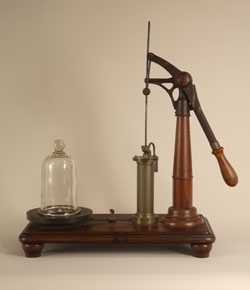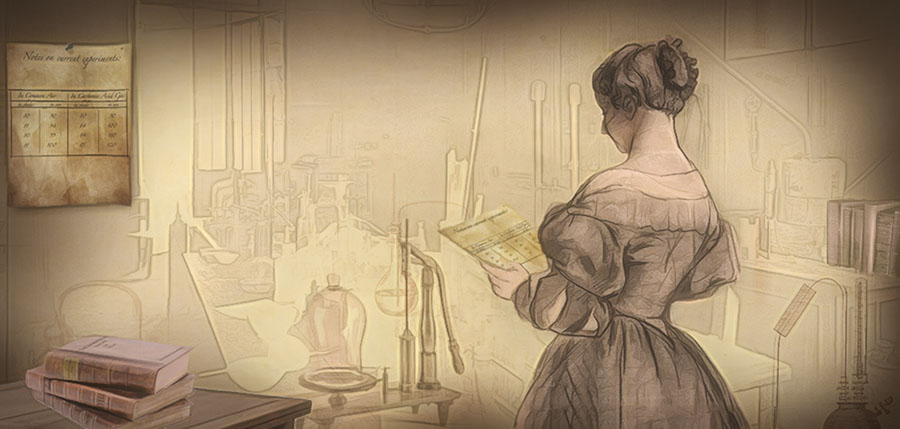Featured Image: Artist rendition of Eunice Foote conducting research on compressed gasses. Image courtesy Carlyn Iverson, NOAA. Featured image courtesy GNU Free Documentation License
Papers: Circumstances affecting the heat of the Sun’s rays; Understanding Eunice Foote’s 1856 experiments: heat absorption by atmospheric gases
Authors: Eunice Foote; Joseph Ortiz and Ronald Jackson
“An atmosphere of [carbon dioxide] would give our Earth a high temperature.”
These words were spoken out loud in August of 1856 at the 10th annual meeting of AAAS, though not by their author. The speaker continues on to suggest that, “[if] at one period of its history the air had mixed with [carbon dioxide] a larger proportion than at present, an increased temperature…must have necessarily resulted.” This paper was the first recorded finding of the link between carbon dioxide and global warming, and was discovered by the female physicist and scientist, Eunice Foote. While these findings were remarkable on their own, she synthesized the implications to correctly state that carbon dioxide concentrations in the atmosphere both increase global warming and can explain Earth’s geologic history, specifically regarding the Devonian period1,2. Despite being on the sidelines of science at the time because of her gender, Eunice Foote provided fundamental and groundbreaking knowledge in the field of gaseous physics.
Foote’s research—which preceded John Tyndall’s descriptions of the greenhouse effect by several years—definitively showed that the Sun’s rays can warm Earth’s atmosphere at different rates depending on atmosphere density and composition, with carbon dioxide creating the warmest atmosphere. More specifically, her paper described three distinct findings: 1) higher density of the atmosphere increases its ability to warm, 2) the atmosphere warms at a higher rate when more water vapor is present, and 3) different gasses have different warming potentials where carbon dioxide creates the highest potential.
To test her hypotheses, it’s likely she used an apparatus similar to the image below, yet the details of her setup are largely unknown. However, we do know that she had a hand-powered air pump that was capable of evacuating or condensing the air in the adjacent brass chamber and glass receiver outfitted with an internal thermometer. Her setup contained two glass receivers next to each other, allowing her to directly compare a control and a test (eg. one in the sun’s rays, the other shaded). She then condensed different gasses such as oxygen, hydrogen, and carbon dioxide, and measured the temperature within the receiver when the gasses were exposed to different levels of sunlight.

The historical context of Foote’s work is documented by an 1856 Scientific American magazine article, in which they detail the early 19th century understanding of climate change as it pertains to Earth’s history. . Specifically, the Phanerozoic was of great interest as fossils were discovered in association with tropical-like vegetation as evidence of past warm conditions. At the time, geologists believed that increased concentrations of water vapor were responsible for the warmer atmosphere. However, Foote’s work directly contributed to the discovery that increased concentrations of carbon dioxide (in tandem with water vapor were responsible for the temperature increase. Her findings were not extrapolated to the Industrial Revolution and future increases of carbon dioxide in out atmosphere, although we now have that context for her research today. It wasn’t until 1859 that physicist John Tyndall expanded out understanding of solar radiation as it interacts and changes Earth’s atmosphere, as the first scientist to describe the greenhouse effect.
A pioneer in her time as a woman of science, Foote received training at the Troy Female Seminary and what is now Rensselaer Polytechnic Institute. While she was never invited to become a member of AAAS despite her many significant contributions to gaseous physics, she was the first woman to be published in the Proceedings of the AAAS. Additionally, she was published in the American Journal of Science and Arts, the Philosophical Magazine, and featured in Scientific American. Foote would publish one additional paper in 1987 regarding static electricity, yet she moved onward to her greater interests in women’s rights and as an inventor. She was a suffragist and worked with Elizabeth Stanton, Elizabeth and Mary McClintock, and Amy Post and attended the Seneca Falls Convention in 1848 as a member of the editorial committee. She and her husband were signatories of the Declaration fo Sentiments which demanded suffrage, social, and legal rights to women. Her work as a scientist and a women’s rights activist resonate today, serving as an inspiration and encouragement for marginalized folks in science and beyond.
1 ‘Scientific ladies-experiments with condensed gases’, Scient. Am. 12, 5 (1856).
2 New York Daily Tribune, 26 August 1856, p. 7.
Eunice Foote, original founder of climate change dynamics, by Jessica Buser-Young is licensed under a Creative Commons Attribution-ShareAlike 4.0 International License.

